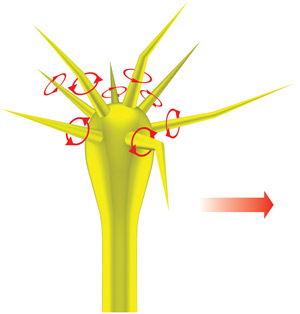Apr. 9, 2010 Research Highlight Biology
Twisting in the right direction
Spontaneous rotating movements cause growing nerve fibers to turn to the right
 Figure 1: Spontaneous rotations of the filopodia cause inherent turning behavior in growth cones. Reproduced from Ref. 1 © Tamada, A. et al.
Figure 1: Spontaneous rotations of the filopodia cause inherent turning behavior in growth cones. Reproduced from Ref. 1 © Tamada, A. et al.
During neural development, immature nerve cells extend axons and dendrites toward their targets then form connections with other cells. At the tip of these extending fibers is the growth cone, a structure with finger-like protrusions called filopodia. As the growth cone moves like an amoeba through the environment, the filopodia detect chemical guidance cues that steer it in the right direction. These processes are dependent on rearrangements of the actin cytoskeleton, a protein scaffold inside the cell.
Now, a team of researchers led by Hiroyuki Kamiguchi of the RIKEN Brain Science Institute has shown that nerve fibers turn clockwise in the absence of external clues, when growing on flat two-dimensional surfaces, because the filopodia rotate of their own accord1.
The researchers first confirmed that nerve fibers from the hippocampus of embryonic rats turn rightwards when grown on a two-dimensional substrate, but grow straight when embedded in a three-dimensional gel. Addition of the fungal toxin cytochalasin D, which stops elongation of actin filaments, prevented the turning of fibers growing on a flat surface, showing that the turning is dependent on the cytoskeleton.
Hypothesizing that filopodia rotate autonomously, the researchers developed a new technique to directly observe the movements in three dimensions. They embedded hippocampal neurons in a gel, so the nerve fibers grew vertically towards the lens of an upright microscope. This revealed that individual filopodia tended to rotate counter-clockwise. This rotation generates a leftward force on the surface, causing the growth cone to turn to the right (Fig. 1).
The researchers then tested whether or not this turning is powered by myosins, the motor proteins responsible for actin-based cellular movements. They transfected hippocampal neurons with three different full-length myosins (Va, Vb and Vc), as well as shortened forms of them that prevent endogenous myosin molecules from binding actin filaments. All were fused to, or co-expressed with, a fluorescent protein to allow easy visualization.
As expected, filopodial rotation was blocked in neurons expressing the shortened myosins, but could be rescued by transfecting the cells with myosins Va and Vb, but not myosin Vc. The rightwards rotation was also observed in neurons from the cerebral cortex, thalamus and cerebellum, suggesting that this is a general mechanism.
Commenting on the findings, Kamiguchi says that: “Rotating filopodia would probe a larger volume of the environment and contribute to the precise perception of cues by the growth cone.”Alternatively, the rotations could promote nerve bundle formation, by enabling new fibers to twine around older ones.
References
- 1. Tamada, A., Kawase, S., Murakami, F., & Kamiguchi, H. Autonomous right-screw rotation of growth cone filopodia drives neurite turning. Journal of Cell Biology 188, 429–441 (2010). doi: 10.1083/jcb.200906043
